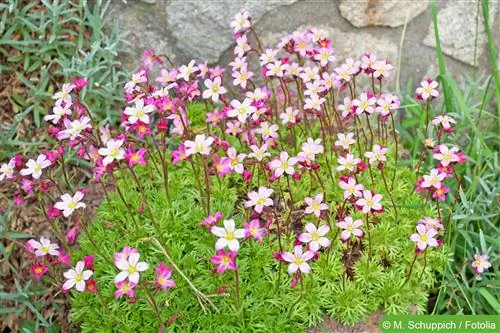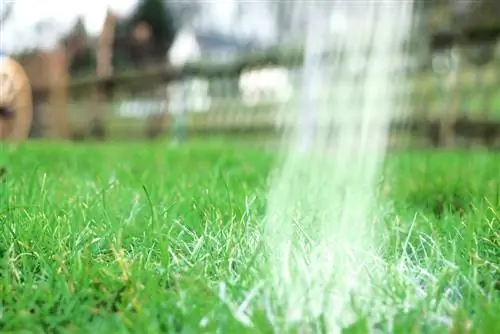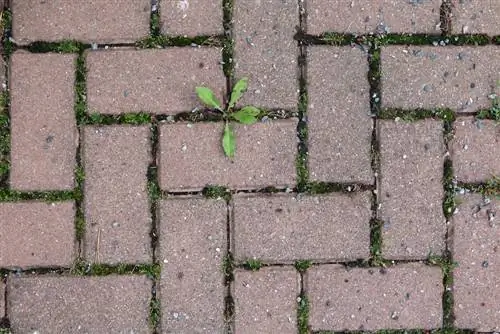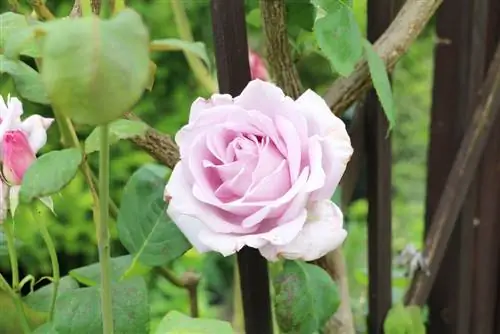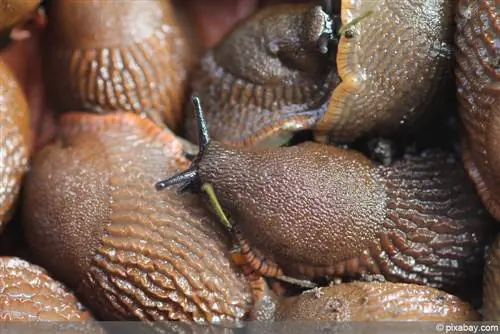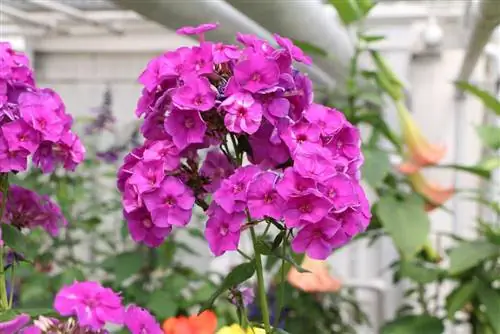- Author admin [email protected].
- Public 2023-12-17 03:39.
- Last modified 2025-01-24 12:45.
Evergreen plants are extremely versatile in the garden and lose none of their green foliage even in winter. Moss saxifrage also belongs to this plant variety. The popular ground cover rarely reaches a height of over 15 cm. The cushiony or moss-like growth of Saxifraga arendsii means that bare spots can be quickly hidden under trees, along roadsides, on graves or in rock gardens. In spring, hobby gardeners can enjoy a lush floral bloom, which shines in the colors white, yellow or red, depending on the variety.
Location and substrate
The moss-like, cushion-forming plants offer a colorful picture, especially when they are in bloom. The herbaceous plants require a protected place in light partial shade. The moss-saxifrage plants are particularly effective as ground-covering underplants for deciduous trees. You can also create a decorative eye-catcher with a small solitary bed. Combine the low saxifrage species together with various cranesbill varieties, carnations or lilies. Whatever you like is allowed, as long as the plants have the same requirements.
The saxifrage family includes well over 460 different species worldwide. As diverse as the plants are in their growth and appearance, their requirements for soil and location are just as different. Moss saxifrage itself requires permeable, humus-rich soil, but can also easily cope with stony ground. You can enrich sandy substrate with clay.
Naming
The German name Moos-Steinbrech is made up of two words, each chosen because of a specific property. The word moss refers to the plant's ability to quickly form moss-like cushions, whereas the word saxifrage refers to its homeland. Especially in the European low mountain ranges, the saxifrage grows between stones and rocks on barren soil and growing between the pieces of rock it looks as if the plant has broken the stone.
Fertilizing and watering
The flat, ground-covering growth makes it difficult to regularly add compost or horn shavings. Saxifraga arendsii is extremely undemanding and thrives even on nutrient-poor soils. However, the plant visibly suffers from the deficiency, which ultimately becomes noticeable in its growth. It makes more sense if you sufficiently prepare the soil once a year, preferably in early autumn. Remove annoying weeds and troublesome saxifrage plants. Spread a thick layer of bark mulch, brushwood or horn shavings between the plants. Moss saxifrage is sensitive to prolonged drought. You should therefore water regularly on hot summer days. Keep the substrate evenly moist and only water in the early morning or evening. This will prevent too much of the valuable liquid from evaporating in the heat before it can reach the plant roots. Waterlogging can also affect the cushion-forming plants. Avoid direct cultivation on bank edges and excessive watering.
Planting
The evergreen, lushly growing plants are planted in the garden in autumn. Beforehand, the soil must be prepared accordingly in order to create the ideal basis for the plants.
- Remove wilted plant debris and annoying roots.
- Enrich the soil over a large area with compost.
- Small pebbles provide a natural drainage effect.
- Dig a sufficiently large planting hole.
- Water vigorously after inserting the moss saxifrage.
Keep a minimum distance of around 15 to 20 cm between the individual plants. The bare spots are quickly closed due to the rapid growth of the plants.
Tip:
Apply an approximately 3 cm thick layer of bark mulch during planting. This binds the moisture in the substrate and supplies the plants with important nutrients.
Propagate
Saxifraga can be propagated via division, cuttings and seeds. All three methods work reliably without much effort. However, experience has shown that vegetatively propagated plants are much more flowery and robust than saxifrage plants grown from seeds.
Division: Dig up an older, strong saxifrage plant in spring and cut it in half with a sharp spade. Then put both parts of the plant back into the substrate as usual.
Cuttings: Under ideal care and location conditions, the cushion-like growing variety quickly develops rooting runners. Use these to fill in bare spots in the bed or to cultivate the plants in another location. The cutting is separated from the rosette with a knife or scissors. Be careful not to damage the delicate roots of the moss saxifrage.
Seeds: Within a short time, capsule fruits form from the wilted flowers, in which the seeds of the saxifrage family ripen. Saxifraga arendsii is one of the “cold germs”. The plant seeds must first go through a cold phase before they germinate reliably. However, sowing seeds directly on the spot is laborious. Because in spring you often tend to germinating weeds rather than the young moss saxifrage plants. You can sow the seeds in a shallow container and place it in a bright spot in the garden. Keep the substrate evenly moist, even during cold winter days. If you don't want to plant the seeds until spring, you should heed the following tips:
- Sowing takes place between mid-February and the end of March.
- First put the seeds in the refrigerator for about 6 weeks.
- Use lean substrate and shallow planter.
- Only cover seeds lightly with soil.
- Keep the soil moist with a water mister.
- The location should be bright and cool.
Prick out the plants in good time and move the young saxifrage plants to their final location outdoors in May or June. The flowers only appear the following year.
Cutting
A classic back and thinning cut is unnecessary for moss saxifrage. In spring you should completely remove dead plants and brown shoots. To prevent self-sowing, you can also cut back the wilted flowers. With a grass trimmer, this work can be done as quickly and efficiently as possible. The measure does not harm the ground cover plants.
Wintering
Saxifraga is an extremely robust plant; many saxifrage species are native to the Alpine region and can withstand double-digit temperatures below zero. Moss saxifrage is no exception and gets through the cold season without any special protective measures. Brown shoots and dead plants are often due to a lack of water rather than frost damage.
Diseases and pests
The evergreen moss saxifrage does not provide an ideal source of nutrition for aphids, snails and other harmful insects. Brown discoloration can occasionally be seen on the leaves. This can be due to several reasons. The moss-like plants are robust, but should not be left to their own devices on particularly hot summer days. Wilted leaves are the first sign that the plants are suffering from a lack of water. Another possible reason: The mossy Saxifraga varieties in particular tend to only develop superficial roots. If growth increases or substrate is washed away during heavy rains, these plants may lose contact with the soil. The plants that are left “in the air” are extremely vulnerable and dry out quickly. Take effective countermeasures immediately. Otherwise, especially in winter, there is a risk that the saxifrage plants will die.
- Relocate moss saxifrage to another location.
- If there is excessive growth, thin out by removing individual plants.
- Top up soil generously.
Conclusion
The perennial, herbaceous saxifrage variety is particularly suitable for cultivation as a ground cover. She plants rock gardens as well as stairs, walls and pathsides. Moss saxifrage is extremely resilient and often grows even under the most unfavorable location and care conditions. The plants are ideal for quickly adding greenery to bare spots in your own garden; the flowers provide an elegant eye-catcher for a few weeks.
What you should know about the moss saxifrage in brief
Profile
- Species/Family: Cushion perennial; belongs to the saxifrage family (Saxifragaceae)
- Care effort: Medium; Although it is easy to care for, it should be done regularly to stay vital
- Flowering time: April to May with medium-sized, delicate cup flowers in pink, red, yellow or white, sitting on thin and branched stems and floating above the foliage
- Foliage: wintergreen; lanceolate, small, pinnately cut leaves in strong green
- Growth: ground cover; quickly forms moss-like cushions
- Height: depending on the variety 3 to 15 cm
- Location: sunny to partially shaded
- Soil: permeable, nutrient-rich, rather dry; can be calcareous
- Planting time: any time as long as the ground is not frozen
- Pruning: does not require pruning, but can tolerate it if necessary
- Partners: Columbine, Bergenia, Fairy Flower, Primrose, Purple Bell, Dwarf Heart Flower
- Propagation: Divide the cushions in spring or autumn, cut unrooted small rosettes and let them root in potting soil indoors
- Care: water if the heat persists so that the soil does not dry out; in spring slow-release fertilizer
- Wintering: hardy
- Illnesses/problems: cannot tolerate constant moisture
Special features
- Moss saxifrage is a breed; the parent species are mainly found in temperate mountain regions
- fits well in the rock garden, where it stands out hanging over walls or stones
- can also serve as a bed border
- can also be cultivated well in pots
- grows even between the smallest joints and gaps
- Plant is not considered to be very persistent, which is why it should be moved regularly in order to enjoy it for a long time
- ideal for north side with lots of light
Varieties
- `Birch Baby: height 3 cm; very small pink flowering variety
- `Flower carpet: stands out with carmine-pink flowers
- `Ingeborg: offers dark red flower carpets
- `Purple carpet: forms a sea of dark wine-red flowers, as can be deduced from the name
- `Snow carpet: very rich in pure white flowers
- `Snow gnome: height 3 cm; This variety got its name from its small growth and the sea of white flowers

